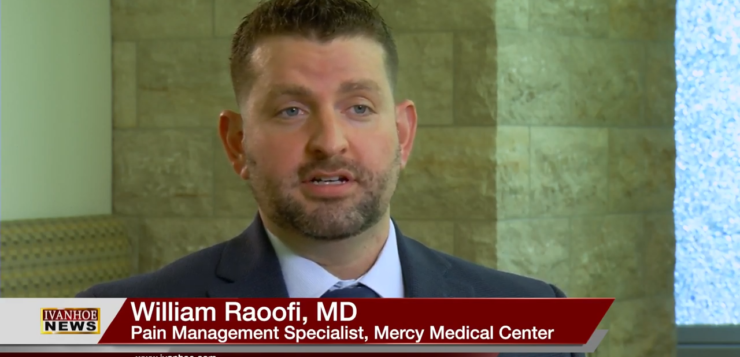William Raoofi, MD, pain management specialist at Mercy Medical Center in Baltimore, Maryland, talks about a new way to treat diabetic neuropathy with spinal cord stimulation
Interview conducted by Ivanhoe Broadcast News in July 2022.
What is diabetic neuropathy and what does it cause?
RAOOFI: Diabetic neuropathy, which can also be called painful diabetic neuropathy, occurs in as many as 50 to 70% of patients with diabetes. Generally, the reasoning behind it occurring is that having high blood sugar, which is what happens in diabetes, you have an elevated amount of glucose in your blood system that kind of wreaks havoc on different systems in our body, and one of those systems is our neurological system. Nerves become sick or injured from the high amount of sugar that’s in our blood or in the blood of a diabetic patient – that results in pain. So, usually the pain is burning pain, what we refer to as kind of a neuropathic characteristic of pain. There’s nothing wrong with the anatomy of the person. They’ll just feel burning pain, usually in the feet, and sometimes it will make its way up into the legs. Sometimes, the hands and arms are involved, too. But most classically it’s the feet and legs. We call it a stocking leg distribution of pain.
Are there any medications or any treatments at this point that can solve the problem?
RAOOFI: There are a variety of medications. One of the most important things is to get diabetes under control, to either slow down the progression of more neuropathy or worsening injury to the nervous system. The most common medications that are used are Gabapentin, Lyrica and Cymbalta or duloxetine. There are other medications used as well. They’re not as commonly used or have side effect profiles that patients just can’t tolerate. But those are the three most common ones that we use as first line therapies.
When those are not doing a patient any good, what’s the next step? What’s left?
RAOOFI: Unfortunately, until recently, there really was no next step. People kind of felt helpless and didn’t really have anything else that they could get from the medical community. Once you failed these medications, it was kind of like, sorry. There’s nothing we can do. Just try to control your diabetes, and any relief you do get from these medications, just accept that that’s the best we can do. However, there’s now an FDA-approved small device, an implanted device. It’s a non-medication device that can help to tone down that pain from diabetic neuropathy. I describe it as like a cardiac pacemaker but for the nervous system. It modulates those nerve firings that are being perceived as pain coming from the sick nerves and kind of turns them down or turns them down to help relieve the pain that the patient is experiencing.
Could you walk me through how this works? You said it’s implantable, almost like a pacemaker for the heart.
RAOOFI: Generally, the first part is someone has to have a diagnosis of diabetic peripheral neuropathy. Once they have that diagnosis, they’ve had to have failed a trial of different medications. And once they’re to the point where they have a diagnosis of diabetic neuropathy, they haven’t responded to medications, the next step is to trial a spinal cord stimulator. This device is implanted in the spinal cord, but it’s not done under a major surgery. It’s done under an outpatient procedure. Generally, we do a trial first, a test to be sure that it works before we move the patient to a permanent implant. In the studies that have been done, over 80% of patients respond to this therapy in the long term. So, the success rate in the trials is pretty high. I usually have patients come in and this is done again under an outpatient procedure. It’s done through a very small needle that’s put in someone’s back, similar to an epidural that a woman might get when she’s in labor, except this is done under X-ray guidance. So, it’s a much easier technique. It’s a lot easier for the patient compared to, for example, a woman in labor getting an epidural. Once the epidural space is accessed with a needle, I then drive a lead under X-ray guidance so that it sits next to their spinal cord. The device is then able to be connected to a temporary pulse generator that then will send signals that can be programmed to modulate those pain signals that are coming from the area where the patient is experiencing their pain.
Where in the spine do you access? Is there a certain level?
RAOOFI: Yeah. We access pretty much the upper part of the lumbar spine, the lower part of the thoracic spine. And the leads are implanted in the thoracic spine, which is the middle back.
Are those leads attached to a stimulator and a power source? A battery? How does that work?
RAOOFI: When a patient is undergoing the trial, the lead is coming out of their skin. We put a sterile bandage to keep everything nice and clean and dry and it attaches to a pulse generator which is also a battery, which I have a model of. That’s the temporary lead. When they go for a permanent implant, we have a different type of battery. It’s very similar to what a cardiac pacemaker would look like, which is both the pulse generator and the battery. The cool thing about this technology is that the batteries are rechargeable. So, someone can have this implanted, and they can recharge it wirelessly through their skin, similar to iPhones these days that you can just place on a wireless charger. The average life of these batteries is around 10 years, so, it’s a long amount of time that they can get relief out of this. Then, once the battery is needing replacement, it’s very easy to have a simple procedure, outpatient, to have the battery replaced.
How often do patients have to recharge?
RAOOFI: Usually, the pulse generator and battery is implanted in the lower back. So, they usually have kind of a belt that they’ll wear around their waist so they can put it on while they’re watching TV at the end of the day, while they’re eating dinner or something like that. How often they charge it really depends on how much juice they’re using from it. Everybody’s going to have a different program, so, they’ll be pulling more energy out of their device. But generally, expectation is they may need to charge it at most once a day at least every few days.
Does the patient have any way of controlling how much stimulation there is, almost like a remote-control device?
RAOOFI: They do have a remote-control device and they can turn the device on and off or use different programs. Generally, for diabetic neuropathy, this technology’s actually been around for a very long time now. It’s particularly with this device, which is known as HFX, has been around for at least a decade and has been implanted in over 80,000 patients. But generally, it’s been used for a different type of pain and now it’s FDA approved for diabetic neuropathy.
How long has it been approved for diabetic neuropathy?
RAOOFI: I can’t tell you the exact date, but it’s within the last year. it’s a very new indication.
What are the implications for having something like this for patients?
RAOOFI: The impact and implications are huge because you can imagine if you’re desperate, you have horrible pain in your feet and legs. You’re told that this is due to your diabetes. You control your diabetes, yet you still have this pain. Now you’re trying different medications that don’t work or cause side effects. And then at the end of it, you’re told, well, there’s nothing that we can do. And now there is something that we can do. People who have received this and had really good results – like I said, over 80% of the patients that have had this device implanted get long-term pain relief and they have huge improvement in their quality of life. They have improvement in their sleep, their ability to function throughout the day. Not to mention that the study actually found that some people had improvement in their sensation in their feet and legs – because a lot of diabetic patients lose sensation in their feet and legs. And there’s still more studies need to be done regarding that, but it’s a very optimistic outcome.
Is it covered by insurance?
RAOOFI: Yes, it is covered by insurance.
How many have you implanted? And do you know how many across the country have been implanted since the approval?
RAOOFI: Well, I’ve been implanting this device for a very long time. It’s very commonly used in pain management and has been that way for more than a decade. And I’ve had really wonderful success in my patients in improving their pain with this. It’s usually a last resort option for people. It’s the last measure we take for people who are quite desperate and haven’t responded to more conventional or conservative or even less conservative approaches for their pain. I’m very optimistic that the diabetic patients that I treat for this will have good results.
Are there any patients for whom this isn’t a good idea or for whom this won’t work?
RAOOFI: Well, you always got to take into consideration every patient’s medical history. There’s always risks to every procedure you do for somebody, and you want to minimize that risk as much as possible. This is an implanted device. Our biggest concern is causing infection. But just like any procedure that someone undergoes, you want to minimize the risk.
Is there anything else that you would want people to know?
RAOOFI: I think the biggest takeaway is that there are more options for these patients. I’ve seen a lot of patients with diabetic peripheral neuropathy and they’re just desperate and they’re told that there’s nothing that can be done for them. They’ve tried everything, and this is really something that can really provide them a lot of relief and improvement in their quality of life.
END OF INTERVIEW
This information is intended for additional research purposes only. It is not to be used as a prescription or advice from Ivanhoe Broadcast News, Inc. or any medical professional interviewed. Ivanhoe Broadcast News, Inc. assumes no responsibility for the depth or accuracy of physician statements. Procedures or medicines apply to different people and medical factors; always consult your physician on medical matters.
If you would like more information, please contact:
Dan Collins
Sign up for a free weekly e-mail on Medical Breakthroughs called First to Know by clicking here




